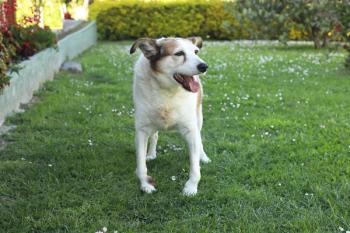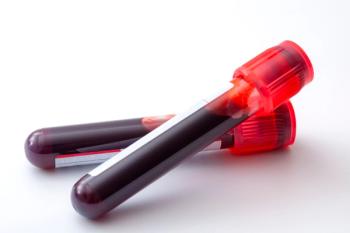
Questions from the dental trenches: Anesthesia and extractions
Get answers to your most commonly asked questions about two essential components of dental care in veterinary patients.
In this three-part series, I’m answering questions I commonly receive at the end of lectures on veterinary dentistry at continuing education conferences and sponsored symposia. In the first part in the May issue, I concentrated on the practical side of veterinary dentistry. This month, I focus on dental FAQs about anesthesia and nerve blocks as well as tooth extractions. If you have a question you’d like to see answered in the final installment, please send an email to
Q. Can patients that receive nerve blocks for oral surgery chew their tongues?
Figure 1: Proper placement of the caudal mandibular block (inferior alveolar block) in a dog. (All photos courtesy Dr. Brett Beckman.)
A. The theory goes that when a caudal mandibular (inferior alveolar) block is performed (Figure 1), sensory innervation to the tongue is blocked, and the patient can chew its tongue, causing significant trauma. There have been reports of patients that have chewed their tongues and caused bleeding and, in at least one particular case, bilateral semicircular defects. These defects occur between the maxillary fourth premolar and the mandibular first molar (carnassial teeth).
The inferior alveolar nerve does not innervate the tongue. The lingual nerve is responsible for sensory signals in the rostral two-thirds of the tongue. There is considerable extravasation of the local agent upon administration, and, because of the reasonably close proximity of the lingual nerve, it is likely that in some cases this nerve is affected. The glossopharyngeal nerve innervates the caudal one-third of the tongue and is most likely the nerve that is responsible for the area in question. So the argument here is that the portion of the tongue that is being traumatized still has intact sensory innervation.
But let us discount that portion of the argument and ask ourselves to imagine the scenario necessary for this to happen. When is this occurring? Not during anesthesia, correct? The patient is anesthetized and does not have the ability to chew. If this were to occur, it would need to occur in recovery prior to the patient maintaining sternal recumbency. If the patient is in sternal recumbency, with or without nerve blocks, the tongue cannot rest in between the carnassial teeth. It either resides in its normal central location or it deviates to either side, resting between the teeth rostral to the carnassial teeth where trauma can’t occur. So the patient must be in lateral recumbency with the tongue resting between the carnassial teeth.
What else is going on here? The patient must be unattended. How many of us would recover a patient under observation and sit back while it macerated its tongue, causing profuse hemorrhage? Fortunately, this is rare to very infrequent, but when it does happen it is prior to full recovery and is the full responsibility of the anesthetic team.
Q. How do I know if a nerve block is placed correctly and is working?
A. The profound benefit of nerve blocks is the provision of patient safety under anesthesia. Nerve blocks allow a much lighter plane of anesthesia, maximizing cardiac output, respiration rate, blood pressure and tissue oxygenation.
At a light plane of anesthesia, the patient can detect the sting of the anesthetic agent injection. Maintaining that light anesthetic plane throughout the entire procedure is our goal in each episode. Therefore, if a nerve block has not been used or for some reason has been incorrectly administered, when an incision is made, the patient reacts with movement or increases in respiration rate, heart rate and blood pressure. We attempt to keep patients light enough that they still have a swallow reflex. This assures the anesthetic team that the nerve blocks are effective.
Q. Do I need to close all extraction sites?
A. We must first qualify what is meant by “extractions.” Simple extractions involve no surgical incision or tissue management; these include the removal of single-rooted teeth, deciduous teeth and, in some cases, two-rooted sectioned premolars. Simple extractions have negligible to no periodontal disease affecting bone, gingiva or palatal tissue.
Figure 2A: Correct surgical exposure for the extraction of the left maxillary canine tooth (204) in a cadaver dog.
Surgical extractions include any extraction in which bone and tissue management is essential. It is indicated in a tooth in which the tissue surrounding the tooth is diseased in any way. This is particularly important in loose teeth. Surgical extraction should be used in any tooth in which surgical exposure is necessary to facilitate a minimally traumatic extraction due to extensive coverage of the root by alveolar bone. The classic example is a fractured canine tooth where the pet guardian declines a root canal but there is no tooth mobility.
Figure 2B: The surgical site after extraction of tooth 204 in a dog.
Opinions vary and variables exist in individual patients, but, as a rule of thumb, if an incisor or two-rooted premolar has no surrounding bone or tissue involvement and can be extracted without a flap and an organized blood clot can successfully be maintained in the alveolus, no closure is needed. But if there is periodontal disease, a flap is essential to expose the defect, clean out debris and granulation tissue, contour the bone and excise inflamed marginal gingiva. The defect is then closed with absorbable sutures. I prefer a monofilament 4-0 to 5-0, depending on the patient’s size.
Figure 2C: Surgical closure of the extraction site in Figure 2B.
Q. Do I need to place a bone graft in all extraction sites?
A. Bone grafts give the opportunity for the marginal bone height in an extraction site to be maintained at its maximum. Therefore, bone grafts are used when additional bone loss would be detrimental. The most common example of this would be the alveolus left after a tooth extraction in which the bone of the adjacent tooth or teeth is thin (Figure 3). If there is considerable distance between the empty alveolus and the adjacent tooth, a blood clot is all that is needed (Figure 4).
Figure 3: The left mandibular fourth premolar tooth (308) is very close to the alveolus of the left mandibular first molar (309). After extraction, a bone graft will aid in maintaining the height of the marginal bone adjacent to 308. Note that the graft is only needed in the mesial alveolus, whereas a blood clot can be left in the caudal alveolus.
Figure 4: This left mandibular second molar (310) has considerable bone between it and the mandibular first molar (309). Extraction of 309 would not require a bone graft because of the distance between the alveolus and 310.
Q. How should I price extractions?
A. Extractions should be priced based on the anticipated time for the procedure as would be a surgery of similar difficulty. Extractions should involve the principles discussed in the question on the closure of extraction sites above and, therefore, do not refer to manually removing a severely mobile tooth without tissue and bone management followed by closure.
Your hourly surgical fee can be used as the base. Extraction of a canine, maxillary fourth premolar or a mandibular molar in a dog might take a trained practitioner 20 to 25 minutes. Smaller teeth take less time in general, depending on location. The more caudal, the more difficult the access. The mandibular second molar in a dog can be difficult, for example. A quadrant in a dog or cat may take 40 to 50 minutes or more, depending on a practitioner’s skill and efficiency, ankylosis, tooth resorption, skull conformation and other factors. Pet guardians should be consulted to explain that estimates may vary depending on difficulty.
Newsletter
From exam room tips to practice management insights, get trusted veterinary news delivered straight to your inbox—subscribe to dvm360.






